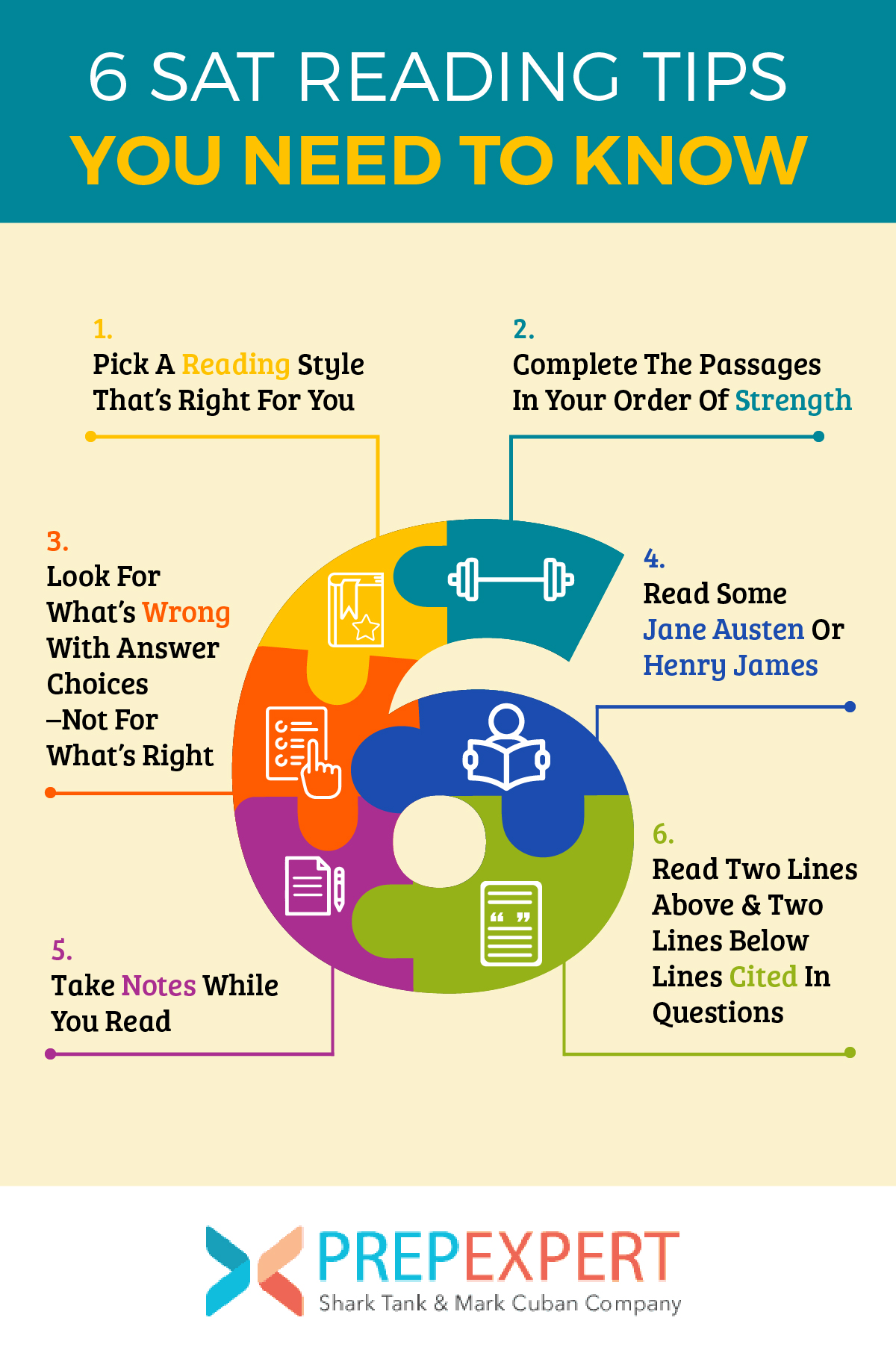6 SAT Reading Tips You Need To Know
For many students, the Reading test is the most difficult part of the SAT–there’s a lot to read, a bunch of questions to answer, and very little time to do so. However, there are things you can do to make this section of the exam easier to complete.
To ace, the SAT Reading test, choose the reading style that’s best for you, complete the passages in the order of your strength, and look for what’s wrong with answer choices, rather than what’s right. Also, be sure to take notes and read enough for the context vocabulary questions.
Take a closer look at these tips below. If you want even more help on the SAT Reading test, consider taking an SAT prep course with Prep Expert.
[sat_one]


Pick A Reading Style That’s Right For You
Whether it’s reading passages in full or skimming, choose an approach that allows you to answer all of the questions in time.
By far, the biggest challenge of the Reading test is timing. For most students, the Reading test would be easy with unlimited time to finish it. However, the test requires you to read six passages and answer over fifty questions, in a little over an hour–a hard slog.
If you’re a bookworm that reads at a particularly high level, then you’ll probably be able to read all the passages in full and answer all the questions, without running out of time or sacrificing comprehension. But, for many students, this task is quite a stretch within the 65 minutes allotted for the Reading test. So, you might want to consider skimming in order to save time.
Skimming involves reading the first and last paragraphs of the passages in full, in order to determine the passage’s main idea. Then, you read the first sentence of each body paragraph, so that you know what point each body paragraph makes.
When you skim, you’ll have to go back and read additional parts of the passage in order to answer the line-cited questions. Go ahead and answer these questions first. Then, after you have read the maximum amount of the passage, answer the general questions (those without line citations).
Skimming is not ideal—it’s always best to have read everything before answering the questions. However, if this is just not possible for you, skimming is your best option for finishing the test in time.

Complete The Passages In Your Order Of Strength
Read your strongest passages first. If a particular type of passage is tough for you, read it last, in case you run out of time and are left to guess.
At the beginning of the Reading test, rank the passages—Fiction, Social Studies, History, and Natural Science—in your order of strength, and complete your best passages first. This method will keep your interest level up, and ensure you have time to answer the questions you’re most likely to get right.
If there is a certain type of passage that you struggle with, you’re likely to get more questions about it wrong. So, whatever section is your worst, you should finish last. After all, it’s best to be left guessing at the end of the test on questions you would have gotten wrong anyway.
If you’re not sure which passages are your best and worst, completing a few practice tests will give you a good idea. And, remember—when you work this way, make sure you don’t absentmindedly bubble in the Scantron incorrectly. That mistake would turn this strategy into a surefire disaster!

Look For What’s Wrong With Answer Choices–Not For What’s Right
Three out of four answer choices are wrong. Identifying problems with answer choices–rather than trying to prove them right— will help you narrow down your options and find the correct answer.
If the College Board wrote incorrect answer choices in ways that made them obviously wrong, the SAT would be an easy test, and not a very useful tool in assessing college readiness. So, instead, the test makers write wrong answers in ways that make them very tempting to choose.
On the Reading Test, wrong answers will either be text taken verbatim from the passage and then changed very slightly in order to be made incorrect; address a supporting detail rather than the main point; or make a claim that relies on an assumption in order to be correct. As I always tell my students–every time you make an assumption on the SAT, you will get the answer wrong.
[leadmagnet_five]
Yet, many students, who are otherwise inclined to answer a question correctly, take a look at the incorrect answer choices and allow their minds to wander, arguing to themselves that these answer choices could be correct if this or that was the case. Any time you catch yourself thinking this way, know that you are on the wrong track. This mindset means that you will make an assumption!
Correct answer choices can always be supported—every single word of them—with direct evidence from the passage. In order to avoid falling for wrong answers, ask yourself what is wrong with the answer choices, rather than what is right with them. For example, is there a word like ‘every’ or ‘always’ that makes an answer choice too extreme to be correct?
Another way to avoid falling for a wrong answer choice is to read the question, and then come up with an answer in your head before looking at the actual answer choices. Then, when you do take a look at the answer choices, match the answer that you came up with on your own to whatever answer choice is closest to it. Most times, you’ll be right on the mark—and you won’t have had your thinking polluted by the temptations of the wrong answer choices.
[sat_two]

Read Some Jane Austen Or Henry James
Reading some pre-1920s literature—for example, Jane Austen or Henry James–will familiarize you with the older style of writing you might encounter on the Fiction and History passages.
Modern writing is relatively straightforward, with arguments being made without many stylistic flourishes (lots of imagery, metaphorical language, et cetera). This is why many students are thrown off when reading the occasional Fiction or History passage–some of which were written pre-1920.
Writing during this time period frequently used images and metaphors to make points, and because of that style, it is often rather thick. Students today find this sort of molasses-like prose difficult to work through. However, you can prepare yourself for these types of passages by reading some pre-1920s writing.
Some great authors to read for this purpose are Jane Austen (author of Pride and Prejudice) and Henry James (author of The Bostonians). For History passages specifically, you can try reading speeches from the Civil War era, or from the Suffragette movement.
Many of the History passages on the New SAT are related to the Civil War (topics such as slavery and the abolition movement), or to the struggle for women’s rights, including the right to vote. Any reading you do of speeches from figures such as Abraham Lincoln or Susan B. Anthony will be good preparation for the Reading test, as well.

Take Notes While You Read
Taking notes while you read will improve your focus and strengthen your understanding of the passages, as well as prevent you from wasting your time re-reading.
Because the Reading test is a time crunch, many students resist the idea of taking notes; some prefer to simply underline as they read. However, there’s a risk of underlining absent-mindedly, so that by the time you’ve reached the end of the passage, you’ve completely forgotten why you underlined something. Or, you might underline too much and render all of it useless.
Note-taking, on the other hand, requires active engagement with the text, so that you will understand more of what you are reading; it also gives you a record of the most important points the passage makes, which will come in handy when you’re answering questions.
Our short-term memories are extremely taxed during the SAT, and can only hold a little bit of information at a time. If you have taken notes, then you don’t have to worry about this. After all, as the Chinese say, “The faintest ink is better than the best memory.”

Read Two Lines Above & Two Lines Below Lines Cited In Questions
For the context vocabulary and other line-specific questions, don’t just read the lines that are cited when you are answering the question. Make sure you read two lines above and two below the citation, as well.
Doing this will give you the proper context for whatever you’ve read when you answer the associated question. You need to know the full context in which a word is used, or point is made, in order to understand its significance. The cited lines alone usually don’t give you the full context.
[sat_three]
For more test strategy, college admissions, and scholarship application tips sign up for our FREE class happening right now!
SAT Reading Tips FAQ
How can I save time when tackling the reading passages themselves?
You might want to consider skimming in order to save time. Skimming involves reading the first and last paragraphs of the passages in full, in order to determine the passage’s main idea. Then, you read the first sentence of each body paragraph, so that you know what point each body paragraph makes.
How do I answer questions with skimming?
When you skim, you’ll have to go back and read additional parts of the passage in order to answer the line-cited questions. Go ahead and answer these questions first. Then, after you have read the maximum amount of the passage, answer the general questions-those without line citations.
How should I tackle how to handle the passages themselves?
Read your strongest passages first. If a particular type of passage is tough for you, read it last, in case you run out of time and are left to guess.
What’s a tip to help me eliminate answer choices?
Look for what’s wrong with answer choices–not for what’s right. Three out of four answer choices are wrong. Identifying problems with answer choices–rather than trying to prove them right— will help you narrow down your options and find the correct answer.
Written by Todd Marcus
More from Todd Marcus

Taking The ACT Junior Year
If you're ambitious and want to give yourself plenty of time for score improvement, then consider taking the ACT junior…

ACT 2020 Score Release Dates
Here then are the ACT 2020 score release dates to plan around, as well as, the different kinds of available…

How To Determine Your Average SAT Study Time
If you want a high score on the SAT, then you need to put in the hours. There's no way…